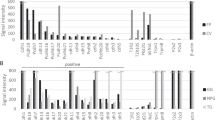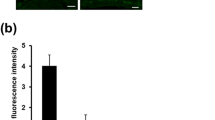Abstract
Functional diversification of taste cells is crucial for proper discrimination of taste qualities. We found the homeodomain protein Skn-1a (Pou2f3) to be expressed in sweet, umami and bitter taste cells. Skn-1a–deficient mice lacked electrophysiological and behavioral responses to sweet, umami and bitter tastes, as a result of a complete absence of sweet, umami and bitter cells and the concomitant expansion of sour cells. Skn-1a is critical for generating and balancing the diverse composition of taste cells.
This is a preview of subscription content, access via your institution
Access options
Subscribe to this journal
Receive 12 print issues and online access
$209.00 per year
only $17.42 per issue
Buy this article
- Purchase on Springer Link
- Instant access to full article PDF
Prices may be subject to local taxes which are calculated during checkout



Similar content being viewed by others
Change history
13 July 2011
In the version of this article initially published, the labels for NaCl and citric acid were reversed in Figure 2c. The error has been corrected in the HTML and PDF versions of the article.
References
Chandrashekar, J., Hoon, M.A., Ryba, N.J.P. & Zuker, C.S. Nature 444, 288–294 (2006).
Chandrashekar, J. et al. Nature 464, 297–301 (2010).
Huang, A.L. et al. Nature 442, 934–938 (2006).
Stone, L.M., Finger, T.E., Tam, P.P.L. & Tan, S.-S. Proc. Natl. Acad. Sci. USA 92, 1916–1920 (1995).
Beidler, L.M. & Smallman, R.L. J. Cell Biol. 27, 263–272 (1965).
Ryan, A.K. & Rosenfeld, M.G. Genes Dev. 11, 1207–1225 (1997).
Jessell, T.M. Nat. Rev. Genet. 1, 20–29 (2000).
Guillemot, F. Development 134, 3771–3780 (2007).
Andersen, B. et al. Science 260, 78–82 (1993).
Andersen, B. et al. Genes Dev. 11, 1873–1884 (1997).
Ohmoto, M., Matsumoto, I., Misaka, T. & Abe, K. Chem. Senses 31, 739–746 (2006).
Acknowledgements
We thank Y. Sato for assistance with the BAC library screening, the staff of the Research Resource Center, RIKEN, for assistance with generating chimeric and transgenic mice, and T. Kondo for useful comments on the manuscript. This work was supported in part by a Grant-in-Aid for Scientific Research (16688006 and 18688020 to I.M., 21780121 to M.O., and 16108004 and 20380183 to K.A.) and Innovative Areas (Systems Molecular Ethology, Y.Y.) from the Ministry of Education, Culture, Sports, Science and Technology of Japan, a grant from the Research and Development Program for New Bioindustry Initiatives (K.A.), an Ajinomoto Amino Acid Research Program research grant (I.M.), and US National Institute on Deafness and Other Communication Disorders research grant R03 DC011143 (I.M.).
Author information
Authors and Affiliations
Contributions
I.M. and K.A. designed the experiments. I.M., M.O. and Y.Y. generated the transgenic and gene-targeting mice. I.M. and M.O. performed histological experiments. M.N. performed electrophysiological and behavioral experiments. I.M. and M.O. analyzed the data. I.M., Y.Y. and K.A. wrote the paper.
Corresponding authors
Ethics declarations
Competing interests
The authors declare no competing financial interests.
Supplementary information
Supplementary Text and Figures
Supplementary Figures 1–6 and Supplementary Methods (PDF 4720 kb)
Rights and permissions
About this article
Cite this article
Matsumoto, I., Ohmoto, M., Narukawa, M. et al. Skn-1a (Pou2f3) specifies taste receptor cell lineage. Nat Neurosci 14, 685–687 (2011). https://doi.org/10.1038/nn.2820
Received:
Accepted:
Published:
Issue Date:
DOI: https://doi.org/10.1038/nn.2820
This article is cited by
-
A vertebrate-wide catalogue of T1R receptors reveals diversity in taste perception
Nature Ecology & Evolution (2023)
-
The proton channel OTOP1 is a sensor for the taste of ammonium chloride
Nature Communications (2023)
-
Ascl1-expressing cell differentiation in initially developed taste buds and taste organoids
Cell and Tissue Research (2023)
-
Identification of cholinergic cells with chemosensory traits in the porcine uterus
Cell and Tissue Research (2022)
-
Fine-tuning of epithelial taste bud organoid to promote functional recapitulation of taste reactivity
Cellular and Molecular Life Sciences (2022)



